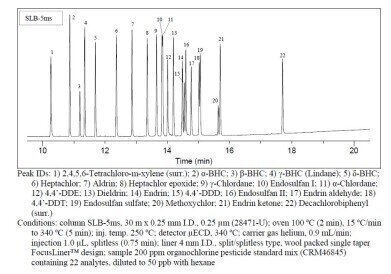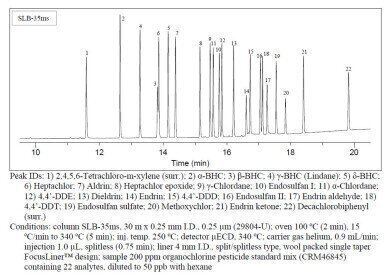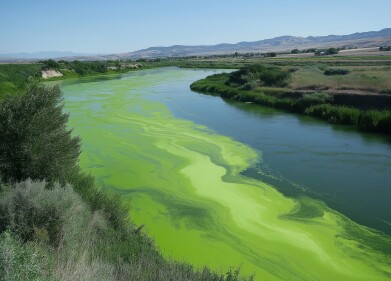-
 Figure 1. Organochlorine Pesticides on SLB-5ms.
Figure 1. Organochlorine Pesticides on SLB-5ms. -
 Figure 2. Organochlorine Pesticides on SLB-35ms.
Figure 2. Organochlorine Pesticides on SLB-35ms.
Environmental laboratory
Dual-Column GC Analysis of Organochlorine Pesticides on SLB-5ms and SLB-35ms
Sep 09 2015
The analysis of low levels of organochlorine pesticides by gas chromatography-electron capture detector (GC-ECD) is routinely performed by analysts in environmental laboratories. Methods require the analysis of each sample extract on two columns with differing selectivity to confirm identifications.
An ECD is highly sensitive, capable of detecting analytes at picogram levels. Its highly sensitive nature, in combination with the low detection limit requirements of promulgated methods (for example, US EPA Method 608, 8081, and OLM04.2 PEST), make it necessary to use GC columns with low bleed. Additionally, the susceptibility of several analytes to degradation and adsorption make inertness another extremely important characteristic when choosing columns.
Dual-Column Analysis
This application requires two columns for the analysis of samples. The first, often referred to as the 'primary' column, is used to determine, by retention time comparison with a standard, if any target analytes could be present in the sample. If peaks are found within an analyte’s retention time window on the primary column, the presence of the analyte must be 'confirmed' on a secondary or 'confirmation' column with a different selectivity in order to be considered positive.
Our SLBms column family is designed for GC and GC-MS analysts who require low bleed, inert, durable, and consistent capillary GC columns. The SLB-5ms is virtually equivalent in polarity to a poly(5% diphenyl/95% dimethyl siloxane) polymer stationary phase. The SLB-35ms is virtually equivalent in polarity to a poly(35% diphenyl/65% dimethyl siloxane) polymer stationary phase. Together, these columns offer the orthogonal selectivity and stringent performance characteristics that are necessary to successfully perform the analysis of organochlorine pesticides using the dual-column approach previously described.
A low-level mixture of twenty organochlorine pesticides and two surrogate compounds, each analyte at 50 ppb, was prepared in hexane. This mixture was first injected on the SLB-5ms column using conditions optimised to achieve maximise resolution. The mixture was then injected on the more polar SLB-35ms column using the same run conditions. The resulting chromatograms are shown in Figure 1 (SLB-5ms) and Figure 2 (SLB-35ms).
On both columns, peaks were easily integrated and baselines were exceptionally stable, with minimal rise observed, even when running to a final oven temperature of 340ºC. The ability of both columns to be used at a high final oven temperature allowed for elution of the last peak, decachlorobiphenyl, in less than 20 minutes. These run conditions were chosen to reduce analysis time, but a slower oven ramp rate can be used to increased resolution if desired.
Discussion
SLBms columns were developed for use in applications using a mass selective detector (MSD). Their extremely low bleed characteristics also make them useful for applications requiring the use of other highly sensitive detectors, such as an ECD.
The proprietary surface deactivation of SLBms columns provides the inertness necessary for the analysis of compounds susceptible to degradation and adsorption, such as organochlorine pesticides. For example, endrin and 4,4’-DDT are susceptible to degradation, and must be monitored. Both of these analytes exhibited good response on both columns.
Digital Edition
AET 28.4 Oct/Nov 2024
November 2024
Gas Detection - Go from lagging to leading: why investment in gas detection makes sense Air Monitoring - Swirl and vortex meters will aid green hydrogen production - Beyond the Stack: Emi...
View all digital editions
Events
Jan 12 2025 Abu Dhabi, UAE
Jan 14 2025 Abu Dhabi, UAE
Jan 20 2025 San Diego, CA, USA
Carrefour des Gestions Locales de L'eau
Jan 22 2025 Rennes, France
Safety, Health & Wellbeing LIVE
Jan 22 2025 Manchester, UK


















